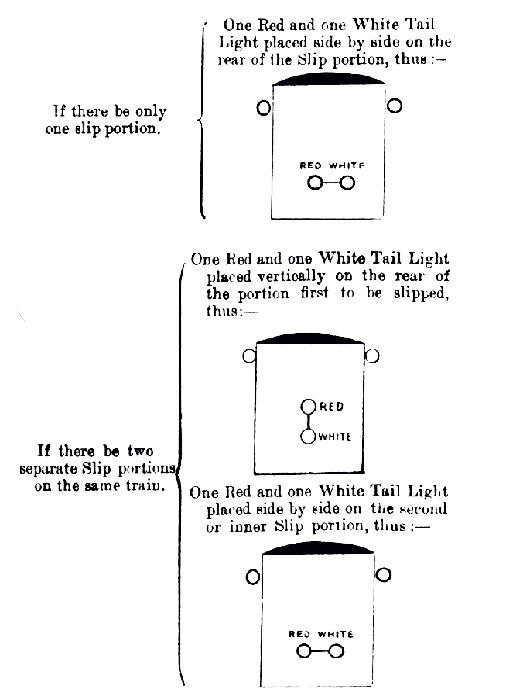125. For the information of Station-masters. Signalmen, and others, each engine must carry the prescribed Head Lamps or Discs, and Destination Boards where provided.
126. Every train travelling on the Line must have a Tail Lamp, properly cleaned and trimmed, attached to the last vehicle, by day as well as by night. The Lamp need not be lighted in the daytime, except in foggy weather or during falling snow, or where otherwise provided, but its presence in the rear of each passing train will furnish evidence to the Signalmen that no portion of the train has become detached.
127. (a) After sunset, and in foggy weather or during falling snow, every engine must carry the necessary Head Lights, and, when running alone, a Red Tail Light also; and except as shown in the following paragraph, or where instructions are issued to the contrary, every train while on any Running Line must carry a Red Tail Light on the last vehicle and two Red Side Lights.
(b) Where trains are run in the same direction on Parallel Lines, special Regulations for Head, Side and Tail Lamps will be made, when necessary, to meet the circumstances of each case.
Note- For details of the practice to be observed, see Appendix to the Rule Book.
(c) The Guard, if there be only one, or the rear Guard, if there be more than one, must see that the Tail and Side Lamps are kept properly burning when necessary.
128. (a) Engines when on any Running Line without a train must carry a Tail Lamp in the rear both by day and by night.
(b) Engines assisting trains in the rear must carry a Tail Lamp.
(c) Engines drawing trains must not carry any Tail Lamp in the rear.
(d) In the case of two or more engines running coupled together without a train, the last engine only must carry a Tail Lamp.
129. Shunting engines employed exclusively in Station Yards and Sidings must, after sunset or in foggy weather or during falling snow, carry both Head and Tail Lamps showing a Red Light or such other Light as may be prescibed.
130. (a) An additional Tail Lamp or a Red Board or a Red Flag by day , or an additional Red Tail Light by night, carried on the last vehicle of a train, or on an engine, indicates that a Special train is to follow, but the additional Tail Signal need not be carried by preceding trains for Special trains of which previous printed or written notice has been given.
(b) A printed or written notice of Special trains must be given where practicable, but when such trains have to run at short notice, and the issue of a printed or written advice is impossible, the train must be telegraphed from the starting point to the necessary Stations in advance. The staff must at all times be prepared for extra trains.
(c) The Station-master or person in charge at the starting point of a special Passenger train, of the running of which no previous printed or written notice has been given, must, when practicable, take care that the additional Tail Signal is affixed on the last vehicle of the preceding train, and he must inform the Guard in charge of it the description and destination of the Special train. The Guard of the train preceding the Special train must inform the person in charge of each Station at which he stops of the description and destination of the train that is following, and take care that the additional Tail Signal is removed from his own train when no longer wanted.
(d) Relief trains, if run without previous printed or written notice, must be considered and treated as Special trains.
131. (a) When Slip carriages are run on a train the indications must be as follows:-
By day the Lamps must be encircled by Discs of the same colour as the lights shown by night.
(b) The Slip portion, or the first carriage where there is more than one to be slipped at the same Station, must, after dusk and in foggy weather or during falling snow, carry a White Head Light, in order that after the Slip portion has been detached, Signalmen and others may see it approaching.
Note.- In addition to the Tail Lamps, as above, each set of "Slips" must carry the usual Side Lights.
For Regulations for Working Slip Carriages, see Appendix to the Rule Book.
